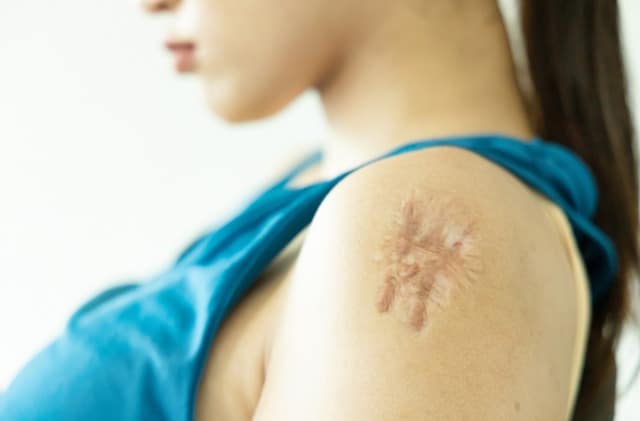After your body experiences a wound, your immune system gets to work in order to heal it. Many people experience an abnormal healing process that results in a hypertrophic scar. Here, we’ll take a look at what these types of scars look like, the common causes of hypertrophic scars, and what you can do to treat them.
What Do Hypertrophic Scars Look Like?
Scarred skin usually appears smooth and seamlessly integrates with the surrounding skin. A hypertrophic scar appears as hard, thickened, and raised tissue over the wound site, and it forms when the body produces excess connective tissue to heal the wound. This skin problem occurs due to the excess production of collagen. Hypertrophic scars are often characterized by their pink or red color and tend to develop in areas where the skin is stretched. Most people find this type of scar develops one to two months after the initial injury and becomes less noticeable as it fades over time.
What Causes Hypertrophic Scars?
Since hypertrophic scars are more likely to form in taut areas of the body, these scars are common on the elbows, back, chest, shoulders, and other joints. Many issues can cause these types of scars to form, including accidents, burns, trauma, inflammation, and surgical incisions. Certain factors increase the risk of developing a hypertrophic scar, including poor healing (often due to an infection), inflammation throughout the body, genetics, and second or third-degree burns.
Hypertrophic Scar Treatment
- Cortisone injections – can be utilized to enhance the appearance of hypertrophic scars caused by acne by reducing redness and inflammation, resulting in a noticeable improvement in the skin’s appearance.
- Skin treatments – Many cosmetic procedures, like microdermabrasion and chemical peels, have proven to be effective in enhancing the look of hypertrophic scars and minor surface irregularities. These procedures delicately eliminate the outer layers of skin and revitalize the underlying layers, resulting in a rejuvenated appearance.
- Laser therapy – effectively removes damaged layers of skin and promotes collagen production, revealing fresh, rejuvenated skin.
Top Hypertrophic Scar Treatments at Westchester Dermatology in Los Angeles, CA
At Westchester Dermatology, our team is here to help you with all your dermatology needs. Whether you’re interested in creating a brighter, more even complexion or you have scarring issues you want to treat, we’ve got you covered. Schedule an appointment with us today by calling (310) 645-6001.


